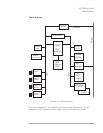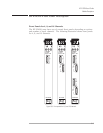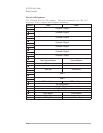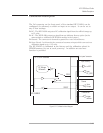
The Local Bus (Option UGV)
The VXI specification includes a 12-wire Local Bus between adjacent
module slots. Using the Local Bus, Hewlett-Packard has defined a standard
byte-wide ECL protocol which can transfer data from left to right at up to
15.7 Mbytes/sec using HP E1432A. If equipped with option UGV, the
HP E1432A can be programmed to output its data using this high speed
port instead of the VME data output register. The Data Port Control
register determines which output port is used.
Local Bus vs VME Transfers
With this option, you can transfer data from the HP E1432A two different
ways; via the VME Bus or via the Local Bus.
The VME Bus is the universal data bus for VXI architecture. It provides
flexibility and versatility in transferring data. Transfers over the VME Bus
can be 16 or 32 bits wide.
The Local Bus supports faster transfer rates than the VME Bus. For
example, if you are transferring data from the HP E1432A to the HP
E1562A/B Throughput Disk Module, the Local Bus provides a direct pipeline
to the HP E1562A/B.
Using the Local Bus, you can transfer data in the background while
processing data in a signal-processing module.
All Local Bus data-transfers originate in an input module and move towards
a signal processing or disk throughput module to the right of the input
module. If other modules generate data to the left of the input module, the
input module will pass the data to its right and append its own data to the
data blocks from previous modules.
HP E1432A User's Guide
Module Description
5-9


















